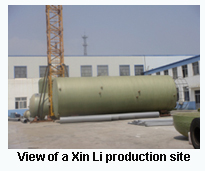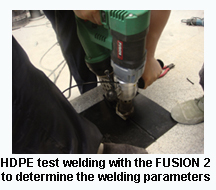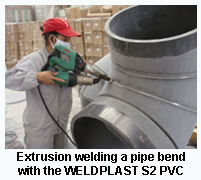|
Extrusion Welding in Chinese Wastewater Treatment Plant

Laiz hou,
a small
town
near Qingdao
– the city
where the
sailing competitions
were
held during
the 2008
Summer
Olympics – is currently undergoing an economic boom.
This may be attributed in part to its favorable transport
connections and to the unique media attention that it
attracted in connection with the Games.
Xin Li Composite Materials Co. Ltd has been among
those companies to benefit from this unparalleled opportunity.
Over the past few years, it has greatly expanded its
product range, transforming itself from a simple supplier
of corrosion-resistant containers to a complete provider of
wastewater treatment plants for the chemical, medical
and metal industries. In doing so, the company has also
extended its sales area, now maintaining a network of
branches covering western China, including the far north.
Pipeline Processing with Hand Extruders
PE and PVC are used in almost all products made by Xin
Li. Some of the prefabricated products are manufactured
using
extrusion
processing or
injection
molding;
however,
these
processes are
only suitable
for relatively
small components
and for
a limited range of shapes. With a steadily increasing
demand in the
Chinese market
for large
containers and
pipes with
complex forms,
 extrusion welding
has
become the
method of
choice when
joining bigger, more intricate parts.
extrusion welding
has
become the
method of
choice when
joining bigger, more intricate parts.
Temperature and Quality Control
No manufacturer can afford to have welding quality
issues when producing large containers or large-diameter
continuous piping. For this reason, manufacturers most
closely monitor temperature to prevent weak weld joints
or overheating – PVC is very sensitive to fluctuations. To
do this, Xin Li uses the WELDPLAST S2 PVC hand extrud
er from
Leister, which
is equipped
with an electronic
temperature
control,
as well as a
display that
shows both
the pre-heat
hot air and
weld zone
temperatures.
Simple, Efficient Welding
Major projects are often executed in very tight timeframes,
putting those working on material processing
under a great deal of pressure for efficiency. Liu Maokai,
Vice President of Xin Li, recalls that prior to using Leister
PVC hand extruders, each seam had to be welded several
times. However, the WELDPLAST S2 PVC typically only
requires one pass. Now that the company employs five
WELDPLAST S2 PVCs, it is able to tender competitively
for even the most technically demanding projects.
 Additionally, as a general rule, pipes with a diameter of
less than 3.28 feet are assembled at the factory and larger elements are welded
directly at the construction
site. With
the WELDPLAST S2
PVC, elbow fittings
and T-fittings can be
welded easily and
then polished to
achieve good surface
quality.
Additionally, as a general rule, pipes with a diameter of
less than 3.28 feet are assembled at the factory and larger elements are welded
directly at the construction
site. With
the WELDPLAST S2
PVC, elbow fittings
and T-fittings can be
welded easily and
then polished to
achieve good surface
quality.
HDPE Pipe Welding
Xin Li also has a FUSION 2 hand extruder, which was in
use before the WELDPLAST S2 PVC, for the welding of
HDPE pipes. Both hand extruders enable welding parameters
(temperature and output) to be quickly adjusted
according to the material used, thus creating consistent,
reproducible welding results.
Resulting Company Growth
Despite a slowing economy, Xin Li is receiving more
orders than ever before. Liu Maokai attributes these
increased orders to the considerable investments made by
the Chinese government and the efficiency and built-in
quality controls of his equipment.
Furthermore, the production of pipes for wastewater
treatment plants has risen as more people invest in protecting
the environment.
For more information, contact a Leister Authorized
Master Distributor: Assembly Supplies (Western U.S.),
800-694-1472, Web: www.hotairtools.com; Heely-Brown
(Southeastern U.S.), 800-241-4628, Web: www.heelybrown.
com; Industrial Heat Sources (Midwestern U.S.),
800-635-0384, Web: www.industrialheatsources.com;
Malcom Company (Northeastern U.S.), 888-807-4030,
Web: www.malcom.com, STANMECH Technologies
(Canada), 888-438-6324, Web: www.stanmech.com.
|